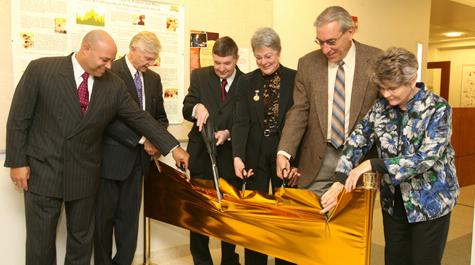Ribbon cut on Integrated Science Center
The ceremony, which was attended by members of the College's Board of Visitors, marked the completion of phase one of the building's construction.
"William and Mary is in the midst of a building boom that got underway at the turn of the century," said President Taylor Reveley. "We gather to celebrate one of the happiest products of that building boom - the Integrated Science Center, phase one, which is now on line and fully populated with faculty, students and staff doing interdisciplinary science."
ISC 1 currently contains the College's chemistry department and eight biology researchers. The second phase of the ISC will completely renovate Rogers Hall. ISC 2, which will be completed in 2009, will house the psychology department and more offices for biology faculty members. The third phase of construction is currently being planned.
"The Integrated Science Center, in its first two phases, allows our Biology, Chemistry, and Psychology faculty to involve students in cutting-edge research and teach them science in a hands-on manner that would not be possible without vastly upgraded power, equipment, and research laboratories in the new buildings," said Carl Strikwerda, Dean of Arts & Sciences.
Paul Heideman, chair of the Department of Biology, said that the new facility is designed to support faculty members' passion for research, "and because we are William and Mary, the ISC is also designed to support students as part of cutting-edge research."
He noted that 300 students every year will do research in the ISC with the intent to contribute toward publication.
"This is not playing at research," he said. "This is real research."
Brooklynd Saar, a senior chemistry major and Dintersmith fellow, discussed the differences between Rogers Hall, where the chemistry department was located, and the ISC. She noted problems with Rogers' ventilation system and climate controls, which occasionally made it "rain" inside because of heavy condensation.
"Because of a number of logistical problems and due to sheer spatial issues, the Rogers building was really hindering the students' ability to experience the full potential of undergraduate research here at William and Mary," she said. "However, I think this new building will continue to allow undergraduate research here in William and Mary to really stand out as truly one of the best, and I think that this will allow us to send out our undergraduate students fully prepared to be successful in both professional life and at graduate school."
During his remarks, Reveley thanked the state and private donors, including Board of Visitors member Sally Gore, for their support. Virginia Governor Timothy M. Kaine visited ISC 1 this summer.
An official dedication of the ISC will be held when phase 2 is completed next year.
















